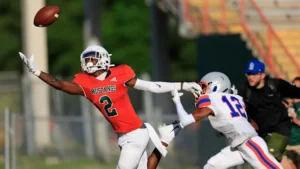
Texcalibur’s Tarnished Edge: Texas Longhorns’ Turnover Sword Sparks Accusations of ‘Stolen Valor’ from Arizona Faithful
The roar of the crowd, the clash of helmets, the elation of a crucial turnover – these are the visceral elements that define college football. Adding a touch of theatrical flair to these momentum-shifting moments has become increasingly common, with teams adopting unique sideline celebrations to ignite their players and captivate fans. However, what is intended as a bit of harmless fun can sometimes ignite a firestorm of controversy, as the Texas Longhorns football program recently discovered. Their adoption of a sideline “turnover sword,” dubbed “Texcalibur,” has been met not with universal amusement, but with a wave of criticism, particularly from supporters of the Arizona Wildcats, the program from which the idea seemingly originated. The accusation leveled against the Longhorns and their co-defensive coordinator, Johnny Nansen, who brought the tradition with him from Tucson to Austin, is a potent one: “stolen valor.”
The concept of a turnover prop is not novel in college football. Teams across the nation have embraced creative ways to celebrate defensive takeaways, ranging from elaborate chains and oversized championship belts to inflatable creatures and even literal turnover trash cans. These props serve as visual rewards for game-changing plays, injecting energy into the sideline and providing a memorable symbol for fans to rally around. When the Texas Longhorns unveiled “Texcalibur” – a gleaming sword plunged into a football after a turnover – it initially seemed like another addition to this growing trend of celebratory sideline antics. Defensive players proudly brandished the sword, posing for cameras and basking in the adulation of the Longhorn faithful.
However, the novelty quickly wore off for a significant segment of college football fans, specifically those who closely follow the Arizona Wildcats. It didn’t take long for the connection to be made: Johnny Nansen, now a key member of the Texas coaching staff, had previously served as the defensive coordinator for the Wildcats. During his tenure in Tucson, Arizona similarly adopted a turnover sword as their sideline celebration. The visual similarities between Arizona’s tradition and Texas’s new prop were undeniable, leading many Wildcat supporters to cry foul.
The outrage wasn’t merely about the imitation of an idea. For many Arizona fans, the turnover sword had become deeply intertwined with the identity and culture of their defense under Nansen. It was a symbol of their tenacity, their ability to create game-changing plays, and a source of pride for a program that has often toiled in the shadows of college football’s elite. To see that symbol now embraced by a powerhouse program like Texas, particularly with the direct involvement of the coach who introduced it to Arizona, felt like a blatant appropriation.
The term “stolen valor,” while often associated with military impersonation, carries a broader connotation of taking credit for something that is not one’s own, particularly something that holds significant meaning or was earned by another. In this context, Arizona fans felt that Texas was attempting to capitalize on a tradition that had been organically developed and embraced by their program. The fact that Nansen, who was instrumental in establishing the sword tradition at Arizona, was now bringing it to his new, more high-profile program only amplified these feelings of resentment.
Social media platforms became battlegrounds for this burgeoning controversy. Arizona fans flooded comment sections and message boards, expressing their anger and disappointment. Many used the hashtag #StolenValor, directly accusing Texas of pilfering a cherished symbol. They argued that while the concept of a turnover prop might be widespread, the specific adoption of a sword, particularly under the circumstances of Nansen’s move, felt like a deliberate act of cultural theft within the college football landscape.
“It’s not just a sword; it was our sword,” one Arizona fan wrote on X (formerly Twitter). “Nansen built that culture with our defense, and now he just takes it to Texas like it’s nothing? It feels like they’re trying to erase what we built.” Another echoed this sentiment, stating, “Texas has all the resources in the world; couldn’t they come up with their own idea? This just shows a lack of originality and respect for what Arizona was doing.”
The criticism wasn’t limited to online fan forums. Some Arizona-based media outlets also picked up on the controversy, highlighting the feelings of betrayal among the Wildcat faithful. They emphasized the emotional connection that fans had formed with the turnover sword during Nansen’s tenure, viewing it as a unique and defining characteristic of their team’s defensive identity.
For their part, the Texas Longhorns have largely remained silent on the issue. There has been no official statement from the program or Coach Steve Sarkisian addressing the accusations of “stolen valor.” Johnny Nansen himself has also not publicly commented on the controversy. This silence has, in some ways, only fueled the fire, with Arizona fans interpreting it as a tacit admission of guilt or a dismissive attitude towards their concerns.
However, some observers have offered a more nuanced perspective on the situation. They argue that while the visual similarity is undeniable, the concept of a sideline prop is not proprietary. Coaches move between programs, and it is not uncommon for them to bring successful strategies and even cultural elements with them. The turnover sword, in this view, is simply a tool that Nansen found effective in building defensive morale and celebrating success, and he is now implementing it in his new environment.
Furthermore, some Texas fans have countered the “stolen valor” accusations by pointing out that the Longhorns’ “Texcalibur” has its own distinct branding and presentation. While the core concept of a sword remains, the specific design and the name are unique to Texas. They argue that this distinguishes it from a direct copy and represents an adaptation rather than a wholesale theft.
Yet, this argument often falls flat with Arizona supporters, who emphasize the emotional and historical context of their turnover sword. It wasn’t just a random prop; it was a symbol that emerged and gained significance within their specific program under a particular coaching regime. The act of transplanting that exact type of symbol to a new, more prominent program under the same coach feels, to them, like an erasure of that history and a co-opting of their unique identity.
The controversy also raises broader questions about originality and inspiration in college football. Where does the line lie between drawing inspiration from another program’s success and outright imitation? Are certain traditions so deeply ingrained in a program’s identity that they become off-limits for others, especially when a coach directly facilitates the transfer?
It’s important to acknowledge that college football is a world of constant adaptation and evolution. Coaches borrow schemes, teams emulate successful strategies, and even sideline celebrations can see variations and iterations across different programs. However, the specific circumstances surrounding the Texas turnover sword – the direct transfer of the tradition by the same coach from a less prominent program to a national powerhouse – have struck a nerve with many Arizona fans.
The power dynamics at play also contribute to the sense of injustice felt by the Arizona faithful. Texas, with its storied history, massive resources, and national profile, is seen as having the capacity to create its own unique traditions. For them to adopt something so closely associated with a program like Arizona, which has historically fought for recognition, feels like a further marginalization. It reinforces the perception that the smaller programs are often overlooked or even exploited by the giants of the sport.
The long-term impact of this controversy remains to be seen. Will the accusations of “stolen valor” fade over time as Texas continues to use “Texcalibur” and potentially develops its own unique associations with it? Or will it remain a point of contention, a symbol of what some perceive as a lack of originality and respect from a more powerful program?
For the Arizona Wildcats, the departure of Johnny Nansen and the subsequent adoption of their turnover sword by Texas likely stings. It serves as a reminder of the cyclical nature of college football, where coaches and even cultural elements can be transient. However, the passionate reaction from their fanbase demonstrates the deep connection that can form between a team, its traditions, and its supporters. The turnover sword, for its brief but impactful tenure in Tucson, became more than just a sideline prop; it became a symbol of their defensive identity and a source of collective pride.
As the Texas Longhorns continue their season, “Texcalibur” will undoubtedly make appearances after key defensive plays. Each time it is brandished, however, it will likely be accompanied by a chorus of disapproval from a significant segment of college football fans who believe that the tradition carries a tarnished edge, forever linked to its origins in the Arizona desert and the lingering accusations of “stolen valor.” The debate serves as a compelling case study in the complex interplay of tradition, originality, and respect within the fiercely competitive and deeply passionate world of college football. It highlights how even seemingly lighthearted sideline celebrations can become potent symbols, capable of igniting intense emotions and raising fundamental questions about the ethics of cultural appropriation in the realm of sports. The shadow of Arizona’s legacy will likely follow “Texcalibur” for the foreseeable future, a constant reminder of the controversy that accompanied its arrival in the Lone Star State.





